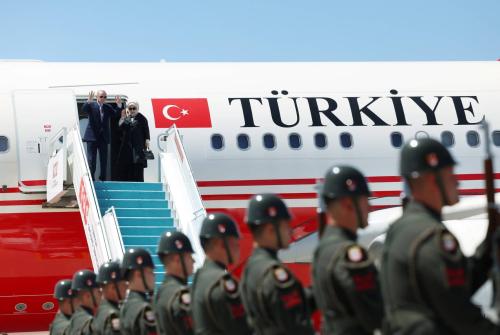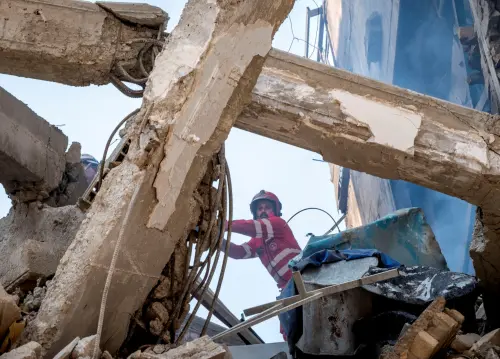Four weeks after North Korea’s latest nuclear detonation, U.S. strategy toward Pyongyang has assumed a decidedly sharper tone and direction. A revised American strategy is seeking to impose appreciable costs on North Korea for its continued nuclear weapons development.
Equally important, a new strategy will directly affect the policy choices of regional states who must address Pyongyang’s pursuit of a weapons capability. The Republic of Korea and Japan are already voicing strong support for U.S. actions. But the principal questions focus on China, Pyongyang’s closest neighbor and its near-exclusive source of economic support and energy assistance.
Sharper tongue
In very explicit language during his January 27 visit to Beijing, Secretary of State John Kerry called North Korea’s latest nuclear test “reckless and dangerous” and (in conjunction with the North’s parallel pursuit of an inter-continental ballistic missile, or ICBM, capability) an “overt threat” that the United States and other nations “must take extremely seriously.” Secretary Kerry also stated that “the United States will do what is necessary to protect the people of our country and our friends and allies.”
Though acknowledging that China and the United States both oppose the North’s weapons development, Secretary Kerry made clear that broad concurrence was no longer sufficient. He argued that there were larger, long-term risks for international security and the integrity of the non-proliferation regime. In a pointed challenge to Beijing, he observed: “All nations, particularly those who seek a global leadership role or who have a global leadership role, share a fundamental responsibility to meet this challenge with a united front,” with “more significant and impactful sanctions” an essential step.
Sanction action plan
A revised strategy presumes that additional sanctions will be passed by the U.N. Security Council. But the content of sanctions will depend on what Beijing and Moscow are prepared to endorse. In his meeting with Secretary Kerry, China’s Minister of Foreign Affairs Wang Yi remarked that “sanctions are not an end in themselves.” He also stated that “the new [Security Council] resolution should not provoke new tension in the situation or destabilize the Korean peninsula.”
But actions that might engender “new tension” or outright destabilization remain in the eye of the beholder. As a skilled diplomat, Foreign Minister Wang did not specify (at least for public consumption) what steps (if any) Beijing will undertake to constrict North Korean actions, or what additional actions China might take to punish Pyongyang. But he signaled that China is not prepared to support all the measures that the United States deems necessary to protect its interests and those of its regional allies.
Because there are clear limits to what China might be prepared to accept in a new Security Council resolution, the United States is actively exploring various unilateral, bilateral, and multilateral measures—also known as secondary sanctions—that go well beyond the particulars that China (and Russia) will entertain.
American officials have yet to disclose the specifics of what is under discussion at the Security Council; some reports indicate that the Chinese have not even reacted to various drafts of a new resolution. Because there are clear limits to what China might be prepared to accept in a new Security Council resolution, the United States is actively exploring various unilateral, bilateral, and multilateral measures—also known as secondary sanctions—that go well beyond the particulars that China (and Russia) will entertain.
U.S. proposals are likely to entail an array of financial measures, heightened activities to impede illicit technology transfers, and political steps to limit North Korea’s international profile and deny it additional diplomatic outreach wherever possible. At the same time, the United States clearly intends to enhance its military activities on or near the peninsula, possibly including a heightened U.S. role in ballistic missile defense. While the United States emphasizes that the latter measures are undertaken on behalf of U.S. allies and are not directed against China, Beijing disbelieves these arguments.
But will it work?
Can a new strategy succeed where previous efforts have underperformed or failed outright? No one argues that new measures will compel North Korea to forego its weapons capabilities or its fissile material holdings. But they will make the costs and consequences to Pyongyang much more explicit and will presumably inhibit more rapid progress in nuclear development. They will also test the extent of cooperation the United States can expect from either China or Russia. At the same time, the United States will heighten its efforts to deny any legitimacy to a nuclear-armed North Korea.
It is doubtful that these measures will impel North Korea to rethink its nuclear aspirations, at least in the near to mid-term. The United States does not expect easy or immediate results from its shift in strategy. However, it has concluded that secondary sanctions are essential to protecting U.S. global and regional interests, and equally vital to reaffirming U.S. commitments to its regional allies. The United States would clearly prefer that China actively cooperate on a much fuller spectrum of measures. But Washington’s message to Beijing is clear: America will act with or without China’s concurrence.
Washington’s message to Beijing is clear: America will act with or without China’s concurrence.
The United States has long believed that China has the means to more decisively oppose North Korea’s nuclear and missile development, including restrictions on China’s financial, economic, and energy assistance to the North. By sharpening the choices confronting Beijing, Washington shows it believes that equivocation or indecision by China is no longer acceptable.
It remains to be seen how Beijing will respond to U.S. moves. But the United States has entered largely unexplored territory. The revised American strategy will test whether Beijing truly believes that North Korea’s nuclear weapons capabilities constitute a long-term danger that it needs to oppose far more vigorously. It will also test whether the U.S.-China relationship is strong enough for both countries to cooperate closely in limiting the nuclear risks posed by a dangerous and endangered North Korean regime.
Note: On February 3, the John L. Thornton China Center and the Center for East Asia Policy Studies at Brookings will host an event to assess North Korea’s nuclear test, weigh the policy responses of the Republic of Korea, Japan, and China, and then consider the implications for U.S. policy. The event will be moderated by Richard Bush and features Katharine H.S. Moon, Sheila Smith, and Jonathan Pollack.
The Brookings Institution is committed to quality, independence, and impact.
We are supported by a diverse array of funders. In line with our values and policies, each Brookings publication represents the sole views of its author(s).




Commentary
Punishing Pyongyang: With new U.S. sanctions, how will China respond?
February 2, 2016